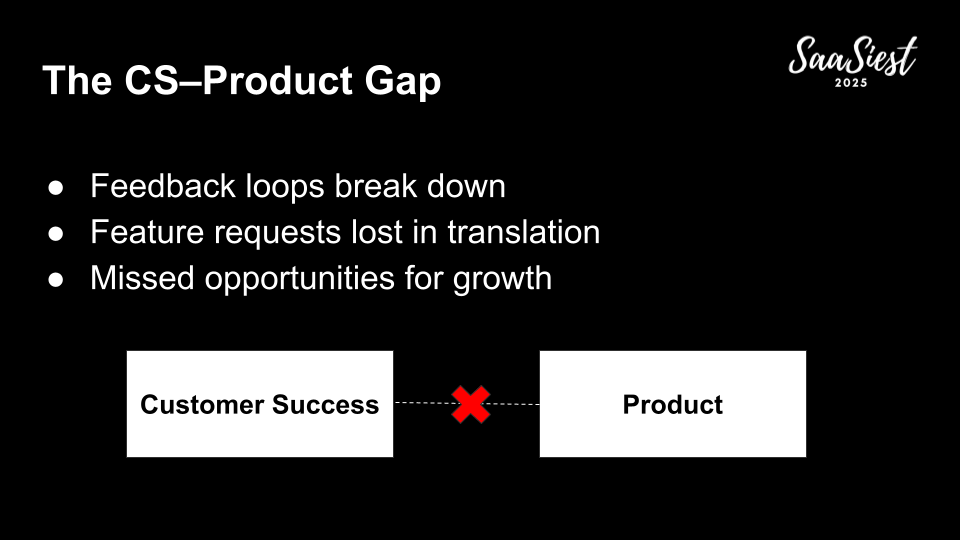What’s the Problem?
Customer Success teams are sitting on a goldmine of insights. They spend their days speaking with customers, hearing what works, what doesn’t, and what customers wish existed. But too often, this feedback disappears into a black hole.
The impact is real: products miss the mark, CS teams burn energy firefighting instead of driving outcomes, and expansion revenue goes untapped.

The numbers make it clear. According to the Product-Led Alliance 2024 State of Product Analytics Report, only 21% of product managers use customer feedback as a key data source. At the same time, once SaaS companies scale, 75% of revenue comes from existing customers. That mismatch is a growth killer.
As Anika Zubair, Founder and CEO of The Customer Success Pro, told the SaaSiest 2025 audience:
“We are all on the revenue team. If your product and CS teams aren’t rowing in the same direction, you’re leaving money on the table.”
Why It Matters Now
In early-stage companies, 80% of revenue typically comes from net-new customers. But as you scale past €10–50M ARR, the picture flips: most revenue growth must come from adoption, expansion, and retention.
If product and CS aren’t aligned, two things happen:
- Features ship but never stick. Customers don’t adopt them, expansion never materializes.
- Revenue risk grows. Frustrated customers churn because product gaps are ignored.
With AI accelerating commoditization and investors scrutinizing efficiency, leaders can’t afford to let this gap persist.
Who Is Anika Zubair?
Anika brings credibility from 12+ years in Customer Success and 4 years in sales. She’s:
- CEO of The Customer Success Pro, a global coaching and enablement platform.
- Advisor to teams at Microsoft, Flywire, and Workiva.
- An award-winning CS thought leader and podcast host.
Her career has been about carrying the “left side of the bowtie” (sales and onboarding) through to the “right side” (adoption and expansion). And at SaaSiest, she shared her Insight to Impact Framework to bridge CS and product alignment.
The Insight to Impact Framework
Anika’s framework helps teams turn raw customer input into product decisions that drive adoption, expansion, and revenue.
1. Capture and Translate
- Capture feedback intentionally. Use call logs, surveys, transcripts, or even spreadsheets. The format matters less than making it systematic.
- Leverage AI. Tools like ChatGPT can structure messy transcripts into actionable themes.
- Translate into product language. Don’t just relay raw quotes. Instead of “Customers didn’t know this feature existed,” frame it as “We need in-app prompts to increase feature adoption.”
2. Collaborate and Prioritize
- Bring CS and product into the same room.
- Use a 2×2 matrix to map initiatives:
- Effort (low/high) vs. Revenue impact (low/high).
- Effort (low/high) vs. Revenue impact (low/high).
- Focus on low-effort, high-revenue opportunities. Everything else belongs in the backlog.
3. Deliver and Close the Loop
- Ship features tied to revenue outcomes.
- Track adoption and expansion post-release.
- Report back to customers: “You asked, we delivered.”
- Always quantify: “This request affects 10 customers worth €300K ARR.” That’s the language that gets leadership buy-in.
Results in Action
At a previous company, Annika applied this framework and saw:
- 22% increase in feature adoption
- 18% uplift in expansion revenue
These results weren’t from chasing shiny features, but from systematic alignment.
Key Takeaways
- Everyone is on the revenue team. Whether you carry a quota or not.
- Translate customer feedback into product requirements. Speak the language your PMs understand.
- Use revenue as the common metric. Tie feedback directly to ARR or NRR impact.
- Close the loop. Customers gain trust, adoption rises, and expansion follows.
Your Next Step
Anika left SaaSiest attendees with three questions to bring back to their teams:
- How are we collecting and prioritizing customer feedback?
- Are CS and Product teams collaborating effectively?
- What processes are in place to close the feedback loop?
Watch Anika’s full session at SaaSiest 2025 here